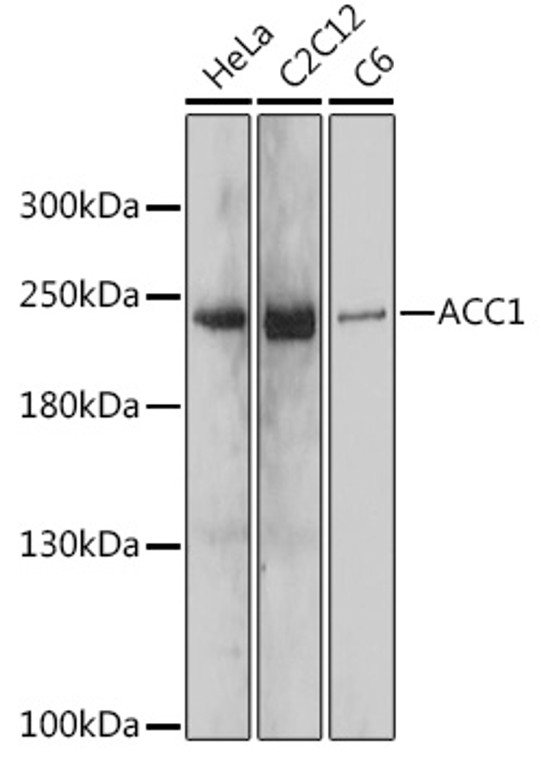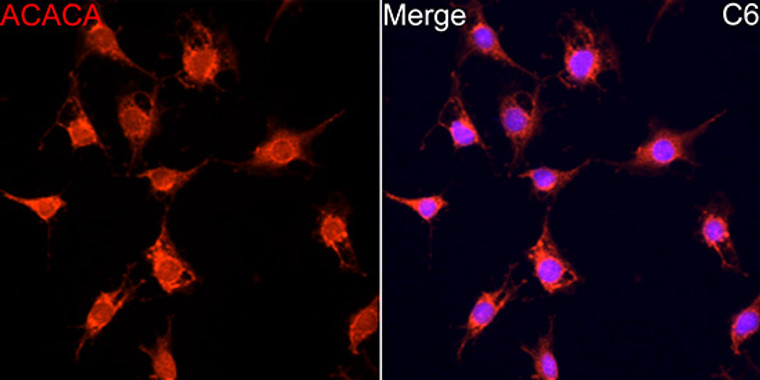| Host: |
Rabbit |
| Applications: |
WB/IHC/IF/IP |
| Reactivity: |
Human/Mouse/Rat |
| Note: |
STRICTLY FOR FURTHER SCIENTIFIC RESEARCH USE ONLY (RUO). MUST NOT TO BE USED IN DIAGNOSTIC OR THERAPEUTIC APPLICATIONS. |
| Short Description: |
Rabbit polyclonal antibody anti-Acetyl-CoA carboxylase alpha (2266-2346) is suitable for use in Western Blot, Immunohistochemistry, Immunofluorescence and Immunoprecipitation research applications. |
| Clonality: |
Polyclonal |
| Conjugation: |
Unconjugated |
| Isotype: |
IgG |
| Formulation: |
PBS with 0.01% Thimerosal, 50% Glycerol, pH7.3. |
| Purification: |
Affinity purification |
| Dilution Range: |
WB 1:500-1:2000IHC-P 1:50-1:200IF/ICC 1:50-1:200IP 1:500-1:1000 |
| Storage Instruction: |
Store at-20°C for up to 1 year from the date of receipt, and avoid repeat freeze-thaw cycles. |
| Gene Symbol: |
ACACA |
| Gene ID: |
31 |
| Uniprot ID: |
ACACA_HUMAN |
| Immunogen Region: |
2266-2346 |
| Immunogen: |
Recombinant fusion protein containing a sequence corresponding to amino acids 2266-2346 of human ACC1 (NP_942133.1). |
| Immunogen Sequence: |
NNKDLAEWLEKQLTEEDGVH SVIEENIKCISRDYVLKQIR SLVQANPEVAMDSIIHMTQH ISPTQRAEVIRILSTMDSPS T |
| Tissue Specificity | Expressed in brain, placenta, skeletal muscle, renal, pancreatic and adipose tissues.expressed at low level in pulmonary tissue.not detected in the liver. |
| Post Translational Modifications | Phosphorylation on Ser-1263 is required for interaction with BRCA1. Phosphorylation at Ser-80 by AMPK inactivates enzyme activity. The biotin cofactor is covalently attached to the central biotinyl-binding domain and is required for the catalytic activity. |
| Function | Cytosolic enzyme that catalyzes the carboxylation of acetyl-CoA to malonyl-CoA, the first and rate-limiting step of de novo fatty acid biosynthesis. This is a 2 steps reaction starting with the ATP-dependent carboxylation of the biotin carried by the biotin carboxyl carrier (BCC) domain followed by the transfer of the carboxyl group from carboxylated biotin to acetyl-CoA. |
| Protein Name | Acetyl-Coa Carboxylase 1Acc1Acetyl-Coenzyme A Carboxylase AlphaAcc-Alpha |
| Database Links | Reactome: R-HSA-163765Reactome: R-HSA-196780Reactome: R-HSA-200425Reactome: R-HSA-2426168Reactome: R-HSA-3371599Reactome: R-HSA-75105 |
| Cellular Localisation | CytoplasmCytosol |
| Alternative Antibody Names | Anti-Acetyl-Coa Carboxylase 1 antibodyAnti-Acc1 antibodyAnti-Acetyl-Coenzyme A Carboxylase Alpha antibodyAnti-Acc-Alpha antibodyAnti-ACACA antibodyAnti-ACAC antibodyAnti-ACC1 antibodyAnti-ACCA antibody |
Information sourced from Uniprot.org
12 months for antibodies. 6 months for ELISA Kits. Please see website T&Cs for further guidance












